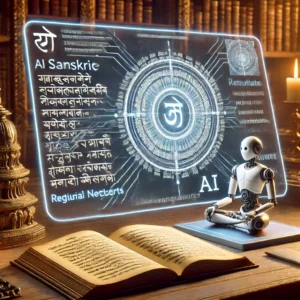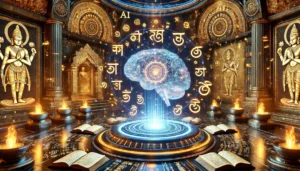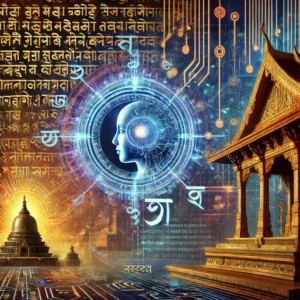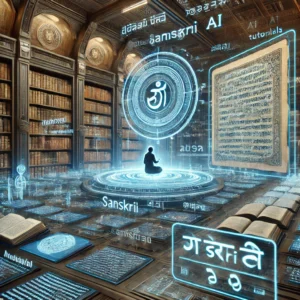
Reviving Sanskrit
AI’s Role in Language Preservation: Reviving Sanskrit
Introduction
Languages are more than just communication tools; they are vessels of culture, history, and identity. Sanskrit, often regarded as the mother of many modern languages and the foundation of India’s spiritual and philosophical traditions, faces the risk of fading into obscurity. Despite its unmatched literary heritage, including texts like the Vedas, Upanishads, and epics like the Mahabharata, Sanskrit is spoken fluently by only a small fraction of the population today.
The rise of artificial intelligence (AI) has sparked hope in language preservation. From translation tools to interactive learning platforms, AI-driven technologies are breathing new life into Sanskrit and other endangered languages. This article explores how AI is playing a pivotal role in reviving Sanskrit, making it accessible, relatable, and popular among a global audience.
The Decline of Sanskrit: Challenges and Concerns
Historical Context
Once a widely spoken and written language, Sanskrit gradually lost prominence due to historical invasions, the rise of regional languages, and shifts in political power. By the colonial era, English emerged as the preferred language of education, further marginalizing Sanskrit.
Modern Challenges
Limited Speakers: Sanskrit is classified as a “revived language,” with few native speakers and enthusiasts primarily in academic and religious circles.
Lack of Accessibility: Sanskrit texts often remain confined to traditional scholars, as they are written in complex structures.
Cultural Disconnect: Modern audiences, especially younger generations, find Sanskrit challenging to learn due to a lack of interactive resources and relatable content.
Table of Contents

Reviving Sanskrit
AI: A New Dawn for Language Revival
Role of AI in Language Preservation
AI, with its ability to process vast datasets, identify patterns, and generate user-friendly tools, offers transformative solutions for ancient languages like Sanskrit. The following are some of the significant contributions AI makes in this field:
Language Modeling and NLP (Natural Language Processing)
AI models like OpenAI’s GPT or Google’s BERT can analyze and generate Sanskrit texts, breaking linguistic barriers.
These models facilitate translation between Sanskrit and modern languages, making ancient texts comprehensible to a global audience.
Machine Translation
Tools like Google Translate now include Sanskrit in their repertoire, offering near-accurate translations of phrases and texts.
Advanced AI algorithms refine these translations, preserving nuances of Sanskrit’s grammatical complexity.
Interactive Learning Platforms
AI-driven language apps such as Duolingo, Memrise, and specialized Sanskrit platforms use gamified learning, voice recognition, and adaptive teaching methods to engage learners.

Reviving Sanskrit
AI-Driven Tools for Learning Sanskrit
- Voice Recognition and Speech Synthesis
AI-powered speech tools allow users to practice proper Sanskrit pronunciation, addressing the challenge of mastering its phonetics. These tools include:
Speech-to-Text Applications: Convert spoken Sanskrit into written text, aiding fluency.
Text-to-Speech Tools: Read aloud Sanskrit verses, making it easier for learners to absorb pronunciations and meter.
- Gamification in Learning Apps
Gamified platforms like ‘Learn Sanskrit’ integrate AI to create quizzes, interactive exercises, and flashcards. AI algorithms adapt the learning pace to the user’s proficiency level, ensuring personalized growth.
- Chatbots for Sanskrit Practice
AI-powered chatbots simulate conversations in Sanskrit, offering real-time feedback and corrections. These bots make practicing Sanskrit less intimidating and more conversational.
- Optical Character Recognition (OCR)
OCR technology powered by AI can digitize ancient Sanskrit manuscripts, converting them into searchable and editable formats. This makes rare texts available for study and research.
- AI-Generated Sanskrit Content
AI systems generate Sanskrit content such as poems, essays, and stories, catering to modern tastes while preserving classical structure. This widens Sanskrit’s cultural relevance.
Popular AI Tools for Sanskrit and Ancient Languages
Sanskrit AI
This dedicated platform integrates AI to offer Sanskrit grammar tutorials, interactive exercises, and tools for composing sentences.
Google Translate
Incorporating Sanskrit into its system, Google Translate bridges the gap between Sanskrit and modern languages, supporting students and enthusiasts worldwide.
Indic NLP Library
An open-source project, Indic NLP processes Indian languages, including Sanskrit, offering tools for transliteration, grammar parsing, and text analysis.
Vision Sanskrit
Using OCR and AI, this tool digitizes ancient Sanskrit manuscripts, providing a platform for researchers to access rare texts.
AI-Powered Sanskrit Chatbots
These bots enable users to converse in Sanskrit, making it easier to apply theoretical knowledge practically.

Reviving Sanskrit
Popularizing Sanskrit Globally Through AI
Bridging Cultural Gaps
AI-powered content creators and translators help non-native speakers connect with Sanskrit texts, fostering cross-cultural appreciation. Translating Sanskrit into global languages ensures that its wisdom is shared widely.
Simplifying Grammar and Syntax
AI tools analyze Sanskrit grammar, breaking it into digestible components. This simplification encourages beginners to explore the language without feeling overwhelmed.
Connecting Sanskrit with Modern Disciplines
AI tools highlight Sanskrit’s relevance in fields like yoga, Ayurveda, and computational linguistics. For instance, AI demonstrates how Sanskrit’s precision benefits coding and programming.
Enabling Virtual Classrooms
AI-driven platforms facilitate virtual Sanskrit courses, allowing students to learn from global experts. Real-time feedback from AI tutors ensures continuous improvement.
Challenges in AI-Based Language Revival
While AI offers immense potential, challenges remain:
Data Scarcity: Sanskrit lacks a large corpus of digitized texts compared to modern languages, limiting AI’s training capacity.
Grammatical Complexity: Sanskrit’s intricate grammar rules require specialized AI models.
Ethical Concerns: Over-reliance on AI may lead to the loss of human expertise in Sanskrit’s nuances.
Cost Barriers: Developing advanced AI tools for niche languages like Sanskrit demands significant resources.
The Road Ahead
Collaborative Efforts
Government initiatives, tech companies, and academic institutions must collaborate to fund and develop AI tools for Sanskrit. Programs like Digital India already emphasize the digitization of ancient texts, a critical step in this direction.
Building Inclusive Communities
AI-driven platforms should create inclusive spaces where Sanskrit enthusiasts can share knowledge, foster dialogues, and celebrate their love for the language.
Expanding AI Applications
AI’s role in Sanskrit preservation can extend to:
Translating Vedic texts for environmental and philosophical insights.
Creating AI-powered Sanskrit music or poetry generators.
Developing AR/VR experiences that immerse users in Sanskrit’s cultural context.

Reviving Sanskrit
Case Studies: Successful AI-Based Sanskrit Initiatives
- Google Translate’s Inclusion of Sanskrit
In 2021, Google added Sanskrit to its language portfolio in Google Translate. This initiative marked a significant milestone for Sanskrit enthusiasts, as it allowed users worldwide to translate phrases, sentences, and texts between Sanskrit and modern languages. Google utilized machine learning algorithms to handle Sanskrit’s complex grammar and provide accurate translations. This has helped students, researchers, and hobbyists access Sanskrit literature more easily.
Impact:
Increased global accessibility to Sanskrit texts.
Motivated tech enthusiasts to explore Sanskrit for cultural and academic pursuits.
- Digital Corpus of Sanskrit Texts
The Sanskrit Heritage Site, supported by AI-powered tools, has created a vast digital repository of Sanskrit texts. By leveraging Natural Language Processing (NLP), the site offers grammatical analysis, transliteration, and interactive access to texts like the Rigveda and Mahabharata.
Features:
AI parses complex Sanskrit texts, highlighting grammatical structures.
Users can search for words, phrases, and concepts across the database.
Impact:
Scholars and linguists gain tools to study Sanskrit in depth.
Students can experiment with composing and analyzing texts.
- Indic NLP Library
Developed as an open-source initiative, the Indic NLP Library focuses on processing Indian languages, including Sanskrit. This AI-powered library supports applications like machine translation, phonetic typing, and grammar checking. For Sanskrit, it offers specialized tools to tackle its unique syntax and semantic rules.
Use Cases:
Transliteration between Devanagari and Roman scripts.
Morphological analysis for identifying the structure of Sanskrit words.
Impact:
Simplifies complex grammar for learners and developers.
Assists in creating interactive Sanskrit learning apps.
- Project Anuvaad by CDAC
India’s Centre for Development of Advanced Computing (CDAC) launched Project Anuvaad, an AI-based translation tool for Indian languages, including Sanskrit. By employing advanced NLP algorithms, the tool can translate Sanskrit texts into regional and global languages while retaining their original meaning.
Key Achievements:
Translated several Sanskrit scriptures into Indian regional languages.
Enabled local researchers to access Sanskrit wisdom without requiring fluency.
Impact:
Promoted Sanskrit’s relevance across diverse linguistic communities.
- Sanskrit 101 on Duolingo
Duolingo, a popular language-learning app, has integrated Sanskrit lessons using AI to create personalized learning experiences. The course includes gamified exercises, vocabulary-building tools, and real-time progress tracking. AI algorithms adapt the lessons based on user performance, ensuring an effective and engaging experience.
Features:
Bite-sized lessons covering vocabulary, grammar, and cultural insights.
Pronunciation exercises powered by voice recognition AI.
Impact:
Attracted younger audiences to Sanskrit learning.
Made Sanskrit a fun and interactive subject for global learners.
- OCR Digitization by Sanskrit OCR Project
A collaborative effort between linguists and tech developers, the Sanskrit OCR Project uses AI to digitize ancient manuscripts. Optical Character Recognition (OCR) technology recognizes Devanagari script and converts handwritten texts into digital formats. These digital archives are made searchable and editable, ensuring the preservation of rare manuscripts.
Use Cases:
Digitizing ancient texts housed in libraries and temples.
Enabling scholars to search for specific verses or themes in extensive scriptures.
Impact:
Preserved fragile manuscripts that would otherwise degrade.
Democratized access to ancient texts for a global audience.
- Voice AI Tools for Pronunciation Practice
Platforms like Vakyartha, developed by IITs in India, use AI-driven speech recognition for teaching Sanskrit pronunciation. These tools compare user speech to native-like pronunciations, offering corrections and suggestions in real time.
Features:
AI listens to Sanskrit recitations and analyzes pronunciation accuracy.
Provides feedback on tone, pitch, and pronunciation.
Impact:
Helped learners overcome the challenge of mastering Sanskrit’s phonetics.
Improved accuracy in reciting Sanskrit verses, crucial for Vedic chanting.
- Google Arts & Culture’s Sanskrit Initiative
Google Arts & Culture has developed interactive AI exhibits showcasing the richness of Sanskrit literature. Users can explore Sanskrit epics, learn about ancient scripts, and interact with translations of key texts.
Key Features:
AI-powered visualizations of Sanskrit grammar and poetry structures.
Interactive displays to explore the Bhagavad Gita, Ramayana, and Upanishads.
Impact:
Enhanced global awareness of Sanskrit’s literary heritage.
Made Sanskrit accessible to audiences with little prior knowledge.
Conclusion
Artificial Intelligence has emerged as a savior for endangered languages like Sanskrit, turning challenges into opportunities. By making Sanskrit accessible, engaging, and relevant to contemporary audiences, AI ensures the preservation of this ancient language for future generations. With sustained efforts and technological advancements, Sanskrit may once again thrive as a living language, connecting humanity to its timeless wisdom.
Through AI, Sanskrit transcends geographical, linguistic, and cultural boundaries, proving that ancient traditions and modern technologies can coexist harmoniously. As we stand at the crossroads of tradition and innovation, Sanskrit’s revival symbolizes the enduring power of language as a bridge between the past and the future.
FAQs on Reviving Sanskrit: How AI is Preserving Ancient Languages for the Future
- How is AI helping to revive Sanskrit?
AI tools like natural language processing (NLP), machine translation, and speech recognition are being used to create language learning apps, translate ancient texts, and improve accessibility for Sanskrit learners.
- What AI-driven tools are available for learning Sanskrit?
Popular tools include apps like Duolingo, Google Translate for Sanskrit phrases, and specialized platforms like Samsaadhanii for Sanskrit grammar and text analysis.
- Can AI translate ancient Sanskrit texts?
Yes, AI-powered translation tools are being developed to translate ancient Sanskrit manuscripts into modern languages while maintaining accuracy and context.
- How does AI promote Sanskrit in education?
AI assists in creating interactive e-learning platforms, virtual tutors, and gamified learning experiences, making Sanskrit more engaging for students.
- Are there challenges in using AI for Sanskrit preservation?
Yes, challenges include the complexity of Sanskrit grammar, lack of annotated datasets, and maintaining cultural and contextual nuances during translation.
- Can AI help preserve other ancient languages too?
Absolutely! AI is being used to preserve various endangered languages worldwide, similar to how it’s aiding Sanskrit revival.
- How does Sanskrit revival benefit society?
Preserving Sanskrit enriches cultural heritage, promotes historical knowledge, and serves as a foundation for understanding ancient Indian sciences and philosophies.
- What role can individuals play in preserving Sanskrit with AI?
Individuals can:
Use AI-based apps for learning Sanskrit.
Promote and share digital resources.
Support initiatives that focus on digitizing ancient texts.
- What is the future of Sanskrit with AI?
With continuous advancements in AI, Sanskrit could become more integrated into education systems, global research, and cultural discussions, ensuring its longevity and relevance.
- Are there any ethical concerns with using AI for language preservation?
Ethical concerns include ensuring the accuracy of translations, respecting the cultural significance of the language, and preventing commercial exploitation of ancient knowledge.
Summary
Reviving Sanskrit: How AI is Preserving Ancient Languages for the Future
Sanskrit, a language rooted in India’s ancient heritage, holds unparalleled historical, cultural, and philosophical significance. However, its decline in active use poses challenges for its preservation. The rise of Artificial Intelligence (AI) offers innovative solutions to revitalize Sanskrit and other ancient languages, ensuring their relevance for future generations.
AI tools, such as natural language processing (NLP) models, machine translation systems, and speech recognition technologies, are being employed to digitize ancient texts, create accurate translations, and develop engaging learning platforms. These technologies are breaking down barriers, making Sanskrit accessible to global audiences through interactive apps, gamified lessons, and pronunciation guides.
Despite challenges like limited datasets and Sanskrit’s complex grammar, AI advancements are bridging gaps between ancient knowledge and modern needs. By preserving Sanskrit, AI not only safeguards a linguistic treasure but also fosters a deeper understanding of the culture, science, and wisdom embedded within its texts.
This intersection of technology and tradition highlights the transformative role AI can play in ensuring the survival of endangered languages, paving the way for their revival in the digital age.
Related Articles
- “Timeless Lessons from Ancient Tales: Linking Samudra Manthan and Ganga’s Descent to Modern Ecological Challenges”
- “Mathura: The Sacred Land of Lord Krishna’s Divine Leelas”
- Investing for Future Generations: Lessons from Indian Traditions on Legacy Building and Wealth Preservation
- “Ancient Indian Wisdom: Timeless Lessons for Tackling Today’s Climate Crisis”
- “Artificial Intelligence and Spirituality: Transforming Ancient Practices for the Modern World”
- “Gold and Real Estate in India: Timeless Assets Shaping Financial Strategies”
- “Divine Feminine Power in Hindu Mythology: The Legends of Durga, Saraswati, and Lakshmi”
- “Divine Beings of Sanatan Dharma: The Spiritual Significance of Sacred Animals in Hinduism”
- “Symbolism in Mythological Art: Unlocking Hidden Meanings in Ancient Temple Carvings”
- “Exploring Technological Advancements in Ancient India and Civilizations: Vimana, Metallurgy, & Water Management systems”
- Unveiling the Mysteries: Ancient Temples of Sanatan Dharma , Mysterious Temples of India
- “The Scientific Knowledge of Sanatan Dharma: Ancient Wisdom Meets Modern Science”
- Ancient Indian Sports and Games: Celebrating a Legacy of Skill, Strength & Strategy”
- “Exploring the Cosmic Link: The Connection Between Astronomy and Vedic Astrology”
- The Power of Sanskrit: Unlocking the Divine Language of the Gods
- “The End of Kaliyuga: A Sanatan Insight into the World’s Final Chapter”
- Explore more articles on Prachin Sanatan Yuga.
Reviving Sanskrit Reviving Sanskrit Reviving Sanskrit Reviving Sanskrit Reviving Sanskrit Reviving Sanskrit Reviving Sanskrit Reviving Sanskrit Reviving Sanskrit Reviving Sanskrit Reviving Sanskrit Reviving Sanskrit Reviving Sanskrit Reviving Sanskrit Reviving Sanskrit Reviving Sanskrit Reviving Sanskrit Reviving Sanskrit Reviving Sanskrit Reviving Sanskrit
